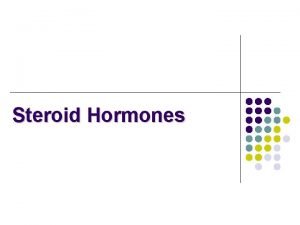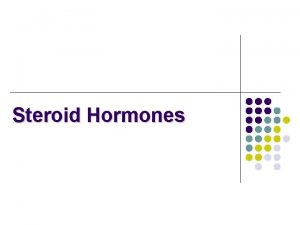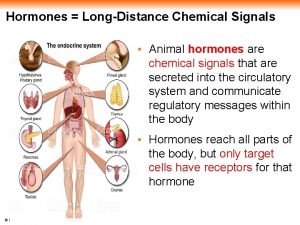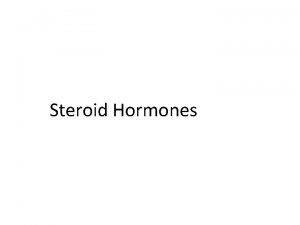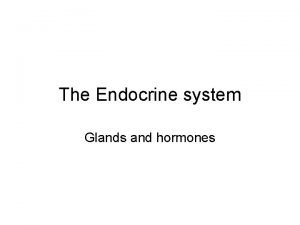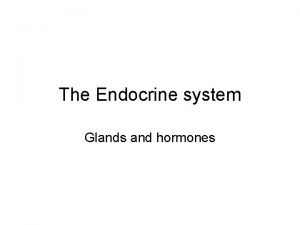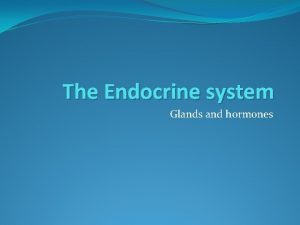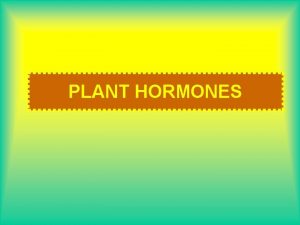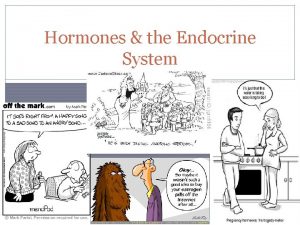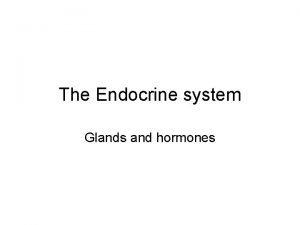Hormones What is Hormones Hormones are the chemical
















- Slides: 16

Hormones

What is Hormones - Hormones are the chemical messengers of the body. They are defined as organic substances secreted into blood stream to control the metabolic and biological activities. -These hormones are involved in transmission of information from one tissue to another and from cell to cell. -These substances are produced in small amounts by various endocrine (ductless) glands in the body.

- They are delivered directly to the blood in minute quantities and are carried by the blood to various target organs where these exert physiological effect and control metabolic activities. -Thus frequently their site of action is away from their origin. Hormones are required in trace amounts and are highly specific in their functions. -The deficiency of any hormones leads to a particular disease, which can be cured by administration of that hormone.

Functions of the hormones Reproduction and sexual differentiation Development and growth Homeostasis Regulation of metabolism Regulation of nutrient supply

Endocrine hormone molecules are secreted (released) directly into the bloodstream, whereas exocrine hormones (or ectohormones) are secreted directly into a duct, and, from the duct, they flow either into the bloodstream or from cell to cell by diffusion in a process known as paracrine signalling.

A paracrine mechanism is defined as chemical communication between neighboring cells within a tissue or organ. Autocrine signals are those in which a chemical acts on the same cell - Intracrine signal is generated by a chemical acting within the same cell.

Endocrine glands


Classification of Hormones Chemical composition Solubility Hydrophopic Hydrophilic Mechanism of action Intracellular receptors Cell surface receptors

Classification of Hormones

Mechanism of hormones action Group I Hormones binds to intracellular receptors. Steroids, T 3, T 4 Group II Hormones binds to cell surface receptors. Amino acid derivatives, glycoprotein



Secreted hormone Growth Hormone Thyroid stimulating hormone (thyrotropin) Abbreviation Effect GH Stimulates growth and cell reproduction TSH Stimulates thyroxine (T 4) and triiodothyronine (T 3) synthesis and release from thyroid gland Stimulates iodine absorption by thyroid gland

Adrenocorticotrophic hormones Follicle stimulating hormone ACTH Stimulates corticosteroid (glucocorticoid and mineralcorticoid) androgen synthesis and release from adrenocortical cells FSH In females: Stimulates maturation of ovarian follicles in ovary In males: Stimulates maturation of seminiferous tubules In males: Stimulates spermatogenesis

Triiodothyronine Thyroxine Calcitonine T 3 T 4 Stimulates body oxygen and energy consumption, increasing the basal metabolic rate Stimulates RNA polymerase promoting protein synthesis Stimulates body oxygen and energy consumption, thereby increasing the basal metabolic rate Stimulates RNA polymerase I and II, thereby promoting protein synthesis Stimulates osteoblasts and thus bone construction Inhibits Ca 2+ release from bone, thereby reducing blood Ca 2+
 Antigentest åre
Antigentest åre Classification of steroids
Classification of steroids Section 2 classifying chemical reactions worksheet answers
Section 2 classifying chemical reactions worksheet answers Chemical reactions section 1 chemical changes
Chemical reactions section 1 chemical changes Section 2 classifying chemical reactions
Section 2 classifying chemical reactions Modern chemistry chapter 7
Modern chemistry chapter 7 Empirical formula pogil
Empirical formula pogil Are kc and kp equal
Are kc and kp equal Số nguyên tố là số gì
Số nguyên tố là số gì Tỉ lệ cơ thể trẻ em
Tỉ lệ cơ thể trẻ em Fecboak
Fecboak Các châu lục và đại dương trên thế giới
Các châu lục và đại dương trên thế giới Thế nào là hệ số cao nhất
Thế nào là hệ số cao nhất Hệ hô hấp
Hệ hô hấp ưu thế lai là gì
ưu thế lai là gì Tư thế ngồi viết
Tư thế ngồi viết Bàn tay mà dây bẩn
Bàn tay mà dây bẩn

